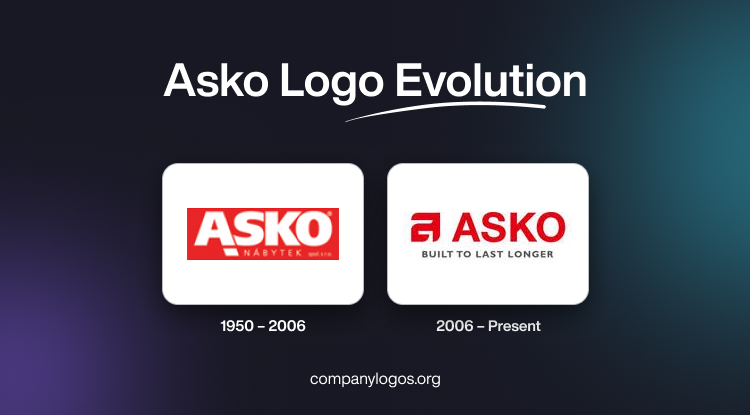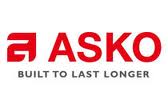
Asko is a globally recognised premium home appliance brand from Sweden. It was founded by Karl-Erik Andersson, also known as the inventor of the washing machine, in 1950. The company has been known for innovation and design excellence for over seven decades. The company’s high-quality product range includes dish washers, washing machines, dryers, kitchen hoods, ovens, stoves, and refrigerators.
In fact, Asko is best known for producing exceptional, high-quality home appliances that combine cutting-edge technology with sleek Swedish aesthetics. In this article, we delve into the fascinating history and evolution of the Asko logo. It is the visual identity of the company and represents the brand’s commitment to quality and sustainability.
The Genesis and Evolution of the Asko Logo (1950 – 2006)
The original Asko logo was introduced in 1950. It comprised a simple and elegant wordmark in uppercase letters, wherein the name of the company was written using a clean, sans-serif typeface. This minimalist design showed the focus of the brand on functionality and efficiency. These were the characteristics that would define Asko appliances. The wordmark of the logo, “ASKO,” was written in white and set against a red background. And just below the right leg of the letter “A” was a solid square-shaped graphic in white. In the decades that followed, the Asko logo was refined by modernising the design without disturbing its core essence.

(2006 – Present)
The most significant evolution of the logo occurred in 2006. It was then the brand unveiled a sleek and contemporary logo that captured the essence of the Scandinavian design principles. The current Asko logo features a bold, minimalist wordmark in a deep, rich shade of red, which evokes a sense of confidence and sophistication. The wordmark in uppercase features the name of the company and a graphic representing the character “A” preceding it.
The clean lines and geometric shape of the logo represent the brand’s adherence to precision engineering and cutting-edge technology. The simplicity and elegance of the Asko logo reflect the company’s dedication to creating top-quality home appliances and other accessories.

The Elements of the Asko Logo
Font
The Asko logo features a clean and stable wordmark written in uppercase and set in a modern, geometric sans-serif typeface. The wordmark features the name of the company. Also, the characters of the logo are characterised by straight and precise cuts to give the logo a crisp and contemporary appearance. The closest font that matches the typeface used in this emblem is Neue Helvetica Georgian 75 Bold or M Ying Hei PRC W7. Both of these fonts capture the sleek and minimalist essence of the logo.
Colour
The colour palette of Asko’s visual identity is a deep and rich shade of red. The wordmark, however, is featured in white. The colour palette offers a sense of calm and sophistication. Besides, it evokes passion and excellence at the same time. The choice of this vivid yet elegant colour underlines the commitment of Asko to provide customer comfort. It, thus, positions the brand as one that prioritises the well-being and satisfaction of its consumers.
The History of Asko
The story of Asko began in 1950, when Karl-Erik Andersson, a visionary entrepreneur, established the company. He had a singular goal, which was to ease the burden of washing clothes by hand for his mother and countless other women. Thus, inspired by the arduous task done by his mother, Karl-Erik designed and built the first Asko washing machine. It was a revolutionary product that would change the face of household chores forever.
The impact of Asko’s first washing machine was immense. The machine’s innovative design and superior performance quickly garnered attention from all quarters. And soon, the brand became a household name known for its quality and reliability. As demand for Asko’s appliances grew, the company expanded its product line. Thus, it introduced refrigerators, dishwashers, and ovens, each of which was meticulously crafted to meet the highest standards of engineering and design.
It was Asko’s commitment to innovation and eco-friendliness that appeared in the unique features of its appliances. For instance, the brand pioneered the use of heat pumps in dryers to reduce energy consumption and environmental impact. Additionally, Asko introduced steam washing cycles and cold-water detergent dispensers. This way, it further enhanced the efficiency and sustainability of its products.
One important attribute of Asko appliances was their exceptional quietness. The design engineers went to great lengths to minimise noise levels. Thus, they ensured that their appliances operated with quiet stillness. This proved their utmost dedication to creating a superior user experience.
In 1982, Asko entered into a partnership with the Italian appliance conglomerate Antonio Merloni. This further cemented the position of the brand in the global market. And under this arrangement, Asko appliances were marketed under the Ariston brand in selected regions, which expanded the company’s reach and accessibility.
As the reputation of Asko for excellence spread, it helped expand its footprints in the European and United States markets. And to meet the growing demand, Asko established state-of-the-art manufacturing facilities in Sweden and Italy. This ensured that every appliance bearing the Asko name adhered to the highest standards of quality and craftsmanship.
Interesting Facts About Asko
- ASKO was founded in 1950 by Karl-Erik Andersson, a young Swedish farmer who designed and built a washing machine to make life easier for his mother. His invention was revolutionary for its time. It featured a stainless-steel drum, water heating, and spinning capabilities, and it quickly attracted interest from others in the community.
- ASKO’s products are deeply influenced by Scandinavian values, such as minimalism, functionality, and craftsmanship. The brand’s design philosophy prioritizes healthy living, fairness, and environmental responsibility, which resulted in appliances that are both beautiful and practical.
- What began as a single washing machine has evolved into a global enterprise. ASKO now offers a full range of premium kitchen and laundry appliances sold in over 50 countries, including the Nordics, USA, and Australia.
- ASKO’s journey includes a merger in 1988 with the Finnish furniture company founded by Aukusti Asko-Avonius. This union brought together Swedish engineering and Finnish design, and shaped ASKO’s modern identity and product range.
- ASKO is known for its dedication to environmental responsibility. The company focuses on water and energy efficiency, durable construction, and sustainable manufacturing practices. It aims to minimize its ecological footprint and create long-lasting products.
- ASKO has a history of innovation, from introducing the Super Cleaning System™ in 1988 to launching the Steel Seal™ washing machine. These eliminate the need for a rubber door bellow to improve hygiene and longevity. ASKO’s latest products, such as the NYACRAFT ovens and Scandinavian Laundry Care 2.0, have won the prestigious iF Design Awards in 2025.
- The legacy of ASKO’s design includes collaborations with renowned Scandinavian designers like Eero Aarnio, whose iconic Ball Chair was released through ASKO in 1966. This reflects the brand’s longstanding commitment to blending innovation with timeless style.
- ASKO’s proximity to the Scandinavian natural landscape has inspired its commitment to environmental stewardship and the use of natural materials. This respect for nature is reflected in both product design and corporate philosophy.
- ASKO’s washing machines are known for their unique engineering, such as having no springs and using four shock absorbers. These enhance stability and durability. The direct connection of the door to the outer drum is another distinctive feature.
- In 2025, ASKO marked its 75th anniversary with a special exhibition at Milan Design Week. It highlighted the legacy of Scandinavian innovation and craftsmanship, and showcased its latest technological advancements and award-winning designs.
Finally
The evolution of the Asko logo is a remarkable journey that reflects the growth and pursuit of excellence of the company. Each iteration of the logo showed the core values of Asko and reflected the company’s attributes of innovation, sustainability, and uncompromising quality. The Asko logo remains a powerful symbol that represents the values and aspirations of the company.